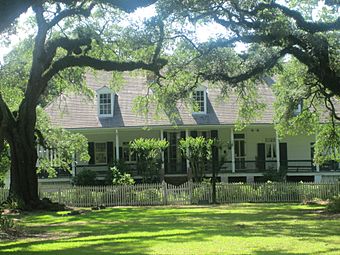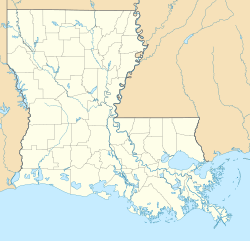Oakland Plantation (Natchitoches Parish, Louisiana) facts for kids
|
Oakland Plantation
|
|

Oakland Plantation House
|
|
| Nearest city | Natchitoches, Louisiana |
|---|---|
| Area | 42 acres (17 ha) |
| Built | 1818 |
| Architectural style | French Colonial Creole |
| NRHP reference No. | 79001073 |
Quick facts for kids Significant dates |
|
| Added to NRHP | August 29, 1979 |
| Designated NHLD | January 3, 2001 |
Oakland Plantation, also known as Bermuda, is a very old farm and home in Natchitoches Parish, Louisiana. It was once called the Jean Pierre Emmanuel Prud'homme Plantation. This place is special because it shows how French Creole cotton farms worked long ago.
Oakland Plantation was a "forced-labor farm." This means that Black people were forced to work there without pay for White owners. Today, the National Park Service owns Oakland Plantation. It is part of the Cane River Creole National Historical Park.
This plantation has been on the National Register of Historic Places since 1979. It is also a National Historic Landmark since 2001. It is an important stop on the Louisiana African American Heritage Trail.
Contents
Exploring Oakland Plantation
Oakland Plantation is located inside the Cane River Creole National Historical Park. This park is part of the Cane River National Heritage Area. The plantation sits on a curve of the Cane River Lake. You can reach it by Louisiana Highway 119. It is near the town of Natchitoches.
Other important places are close by. The Magnolia Plantation is another National Historic Landmark nearby. The Melrose Plantation is also in the area. Oakland Plantation is connected to the Atahoe Plantation and the Cherokee Plantation. It is also linked to the Isle Brevelle community, which is a local Creole community.
A Look at History
The 1800s at Oakland
The first owners of Oakland Plantation were Jean-Pierre Emanuel Prud'homme and his wife, Marie Catherine. They received the land in 1785. The main house was finished around 1821. The Prud'homme family was one of the first in the area to grow a lot of cotton. Enslaved African Americans were forced to plant and pick this cotton.
The plantation also had many farm animals. There were buildings for them, like a dipping vat for animals, a turkey shed, and a mule barn. There were also two pigeonniers (buildings for pigeons) and several chicken coops. By 1795, 38 enslaved African Americans lived and worked at Oakland Plantation.
The Prud'hommes also ran a general store on the plantation. This store was also the local U.S. Post Office for many years. The plantation grew a lot in the 1800s. By 1860, 160 enslaved African Americans were forced to work there. They harvested cotton, worked in the house, or made tools and furniture.
After the American Civil War, slavery ended. But Oakland Plantation still grew a lot of cotton. Many people, often descendants of the formerly enslaved people, became "sharecroppers." Sharecroppers worked small plots of land and lived in cabins on the property. They shared their crops with the landowner. In the 1960s, machines started doing more of the cotton farming. Because of this, families like Elvin Shields's family were asked to leave. This ended the sharecropping era at Oakland Plantation.
The 1900s and Beyond
In 1904, J. Alphonse Prud'homme, a descendant of the original owners, won a gold medal. He won it at the 1904 World's Fair in St. Louis. He won for growing the best cotton in the Southern United States.
The Cane River Creole National Historical Park was created by Congress in 1994. In 1997, the National Park Service bought the main buildings and land of Oakland Plantation for the park. The National Park Service has worked hard to protect and fix up the many old buildings. They have also furnished the inside of the main house. It looks like it did in the 1860s, at the end of the plantation era.
The park teaches visitors about the history of "freedmen" (people who were freed from slavery) and "Creoles of color." These people and their families lived and worked at Oakland Plantation for almost 100 years after the Civil War. They were a very important part of the community. In 2018, the National Park Service made five documentary films. These films share the stories of people connected to both Oakland and Magnolia Plantations. The Prud'homme family is still strongly connected to the plantation, and many of their descendants live in the area today.
Images for kids
See also
- Antebellum architecture
- National Register of Historic Places listings in Natchitoches Parish, Louisiana
- List of National Historic Landmarks in Louisiana
- Cane River National Heritage Area topics
- Plantations in Louisiana







